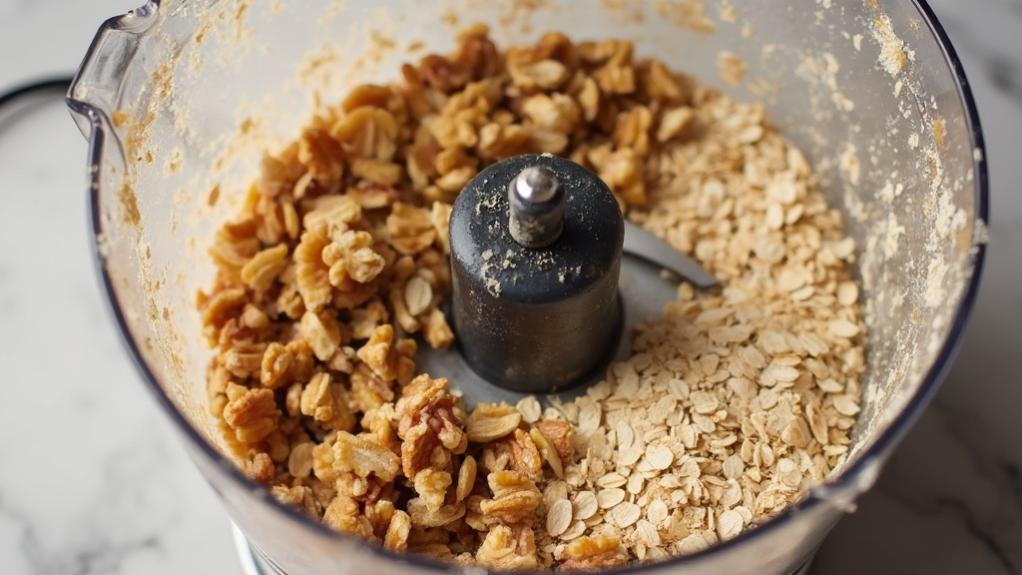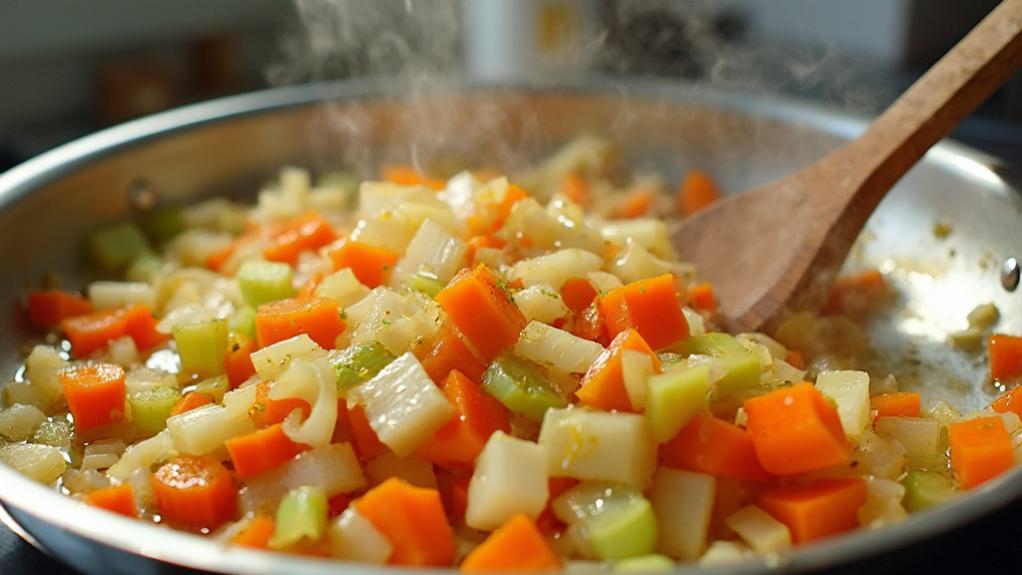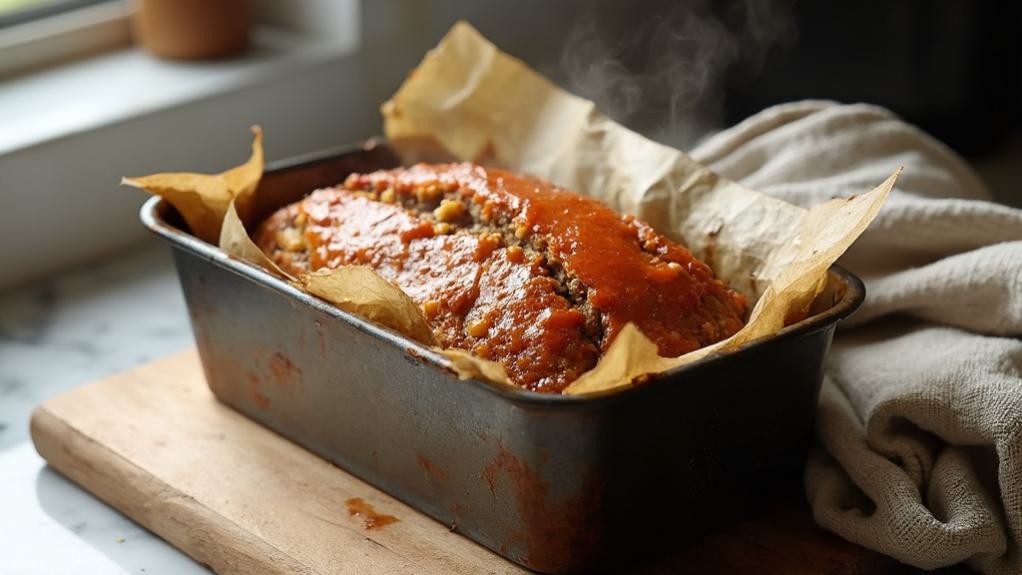I’ve spent countless hours perfecting this lentil loaf recipe, testing every possible combination of ingredients and techniques until I achieved what I’d consider the holy grail of plant-based entrées. The marriage of earthy lentils with sweet maple glaze creates an unexpected symphony of flavors that I’m convinced will convert even the most dedicated meat enthusiasts.
While the traditional meatloaf has its place in culinary history, I’ve discovered that this sophisticated interpretation offers something far more intriguing. Let me guide you through the nuances of crafting this remarkable dish, where texture and taste unite in perfect harmony.
Recipe
This wholesome vegan lentil loaf delivers all the comfort and satisfaction of traditional meatloaf while being completely plant-based. The combination of green lentils, vegetables, and walnuts creates a rich, hearty texture that holds together beautifully when sliced, making it an impressive centerpiece for any meal.
The maple-tomato glaze adds a perfect balance of sweet and savory flavors while helping to seal in moisture during baking. This loaf not only provides excellent protein content from the lentils but also offers healthy fats from walnuts and complex carbohydrates from oats, making it a nutritionally complete main dish.
- 2 cups cooked green lentils
- 1 cup rolled oats
- 1 cup chopped walnuts
- 1 large onion, diced
- 2 carrots, finely diced
- 3 celery stalks, finely diced
- 4 garlic cloves, minced
- 2 tablespoons ground flaxseed
- 1/4 cup water
- 2 tablespoons olive oil
- 1 tablespoon soy sauce
- 1 teaspoon dried thyme
- 1 teaspoon dried sage
- 1/4 cup maple syrup
- 2 tablespoons tomato paste
- Salt and pepper to taste
Preheat oven to 375°F (190°C). Begin by combining ground flaxseed with water in a small bowl and let stand for 10 minutes to create a flax egg.
Heat olive oil in a large pan and sauté onion, carrots, celery, and garlic until soft and translucent, about 5-7 minutes.
Process oats and walnuts in a food processor until coarsely ground. In a large bowl, combine the cooked lentils, ground oat-walnut mixture, sautéed vegetables, flax egg, soy sauce, thyme, sage, salt, and pepper. Mix thoroughly until well combined.
Press mixture firmly into a lined 9×5 inch loaf pan. Whisk together maple syrup and tomato paste, then spread evenly over the top of the loaf. Bake for 45 minutes until firm and the glaze has caramelized. Allow to cool for 10 minutes before slicing.
For optimal results, avoid overcooking the lentils as they should maintain their shape while being tender. The mixture can be prepared up to 24 hours in advance and stored in the refrigerator before baking.
If the top begins to brown too quickly during baking, cover with aluminum foil. To achieve clean slices, let the loaf cool for the full 10 minutes before cutting.
Store leftover slices in an airtight container in the refrigerator for up to 5 days, reheating individual portions in the microwave or oven until warmed through.
Step-By-Step Cooking Instructions
You’ll begin crafting your lentil loaf by combining ground flaxseed with water and letting the mixture develop into a binding agent while you process the walnuts and oats into a coarse meal.
Next, you’ll sauté your aromatic vegetable mixture until tender before incorporating it with the remaining ingredients in a large mixing bowl.
Once you’ve pressed the mixture into your prepared loaf pan and topped it with the maple-tomato glaze, you’ll bake it until golden brown and let it rest for optimal slicing.
Step 1. Soak Flaxseed Mixture First

Begin your lentil loaf preparation by combining 2 tablespoons of ground flaxseed with 1/4 cup of water in a small bowl, allowing this mixture to rest for 10 minutes until it develops a gel-like consistency. This crucial first step creates a natural binding agent that’ll help hold your loaf together, similar to how eggs function in traditional meatloaf recipes.
While you’re waiting for the flaxseed mixture to thicken, you can efficiently use this time to start preparing your other ingredients. Dice your onions, carrots, and celery into uniform pieces, and mince your garlic cloves.
The flaxseed mixture will continue developing its binding properties as you work, transforming into a viscous substance that’s essential for the loaf’s structural integrity.
Don’t rush this process, as properly hydrated flaxseed creates the optimal binding effect. You’ll know the mixture is ready when it reaches an egg-like consistency and feels slightly gelatinous to the touch.
This natural egg replacer will ensure your lentil loaf maintains its shape when sliced, preventing it from crumbling during serving.
Step 2. Process Walnuts and Oats

In a food processor fitted with a steel blade, combine one cup of rolled oats and one cup of chopped walnuts, pulsing them together until they reach a coarse, crumbly texture.
You’ll want to achieve a consistency that’s neither too fine nor too chunky – aim for pieces about the size of coarse breadcrumbs. This mixture will serve as the binding foundation for your lentil loaf, providing essential structure and a delightful nutty flavor profile.
Watch the processing carefully, as you don’t want to over-blend the ingredients into a paste or butter-like consistency.
Pulse in short, controlled bursts of 2-3 seconds each, stopping to scrape down the sides of the bowl as needed. You’ll know you’ve reached the ideal texture when the mixture holds together slightly when pressed between your fingers but still maintains distinct pieces of both oats and walnuts.
This careful processing ensures your finished loaf will have the perfect balance of cohesion and texture, while allowing the individual flavors of both ingredients to shine through.
Step 3. Saute the Vegetable Mixture

While the walnut and oat mixture sets aside, heat two tablespoons of olive oil in a large skillet over medium heat until it shimmers.
Add your diced onions first, allowing them to cook for 3-4 minutes until they begin to turn translucent. You’ll want to stir occasionally to ensure even cooking and prevent any browning.
Next, add the finely diced carrots and celery to the softened onions. These vegetables should be cut to similar sizes for consistent cooking.
Continue sautéing for another 5-6 minutes, stirring periodically, until the carrots have softened but still maintain a slight crunch. You’ll notice the vegetables developing a sweet, aromatic fragrance as they cook.
Finally, add the minced garlic to the vegetable mixture. It’s important to add garlic last, as it cooks quickly and can become bitter if overcooked.
Sauté for just 1-2 minutes more, until the garlic becomes fragrant but hasn’t started to brown. Season the mixture with a pinch of salt and pepper, which will help draw out the vegetables’ natural flavors.
Remove the skillet from heat and let the mixture cool slightly before incorporating it into your loaf.
Step 4. Combine Ingredients in Bowl

Moving on to the crucial assembly stage, you’ll need a large mixing bowl to bring together all your meticulously prepared components.
Start by adding your cooked green lentils, ensuring they’re well-drained to prevent excess moisture. Next, incorporate your processed oat and walnut mixture, which will serve as the crucial binding agent for your loaf.
Add your sautéed vegetable mixture to the bowl, followed by the flax egg you’ve prepared earlier. The combination of ground flaxseed and water should now have a gel-like consistency that’ll help hold everything together.
Drizzle in the olive oil and soy sauce, then sprinkle your dried herbs – thyme and sage – over the mixture. Season generously with salt and pepper to achieve the perfect flavor balance.
Using clean hands or a sturdy wooden spoon, thoroughly combine all ingredients until they’re evenly distributed throughout the mixture.
You’ll want to work the ingredients together until you can easily form a handful that holds its shape when squeezed. The texture should be moist but not wet, and well-combined but not overly processed.
Step 5. Bake and Let Cool

Now that your lentil mixture is thoroughly combined, you’ll begin the final stage of transforming these wholesome ingredients into a beautifully baked loaf.
Transfer the mixture into your prepared loaf pan, pressing it down firmly and evenly with the back of a spatula to eliminate any air pockets. In a small bowl, whisk together the maple syrup and tomato paste until smooth, then spread this glaze evenly across the top of your loaf.
Place the pan in your preheated 375°F oven and bake for 45 minutes, or until the glaze has caramelized and the edges have turned golden brown. If you notice the top browning too quickly, simply cover it with aluminum foil to prevent over-darkening.
Once done, you’ll want to let your loaf rest for at least 10 minutes before attempting to slice it – this crucial cooling period allows the internal structure to set properly, ensuring clean, photo-worthy slices.
You’ll know it’s ready when a knife inserted into the center comes out clean and the loaf feels firm to the touch.
Why I Love This Dish
I’ve grown to cherish this lentil loaf for three compelling reasons: its remarkable versatility as a centerpiece dish, its rich depth of flavor that rivals traditional meatloaf, and its wholesome nutritional profile.
As someone who frequently entertains both vegetarians and meat-eaters, I’m consistently amazed by how this loaf commands attention at the dinner table. The combination of green lentils and walnuts creates a satisfying texture that slices beautifully, while the maple glaze adds a sophisticated touch that elevates it beyond typical vegetarian fare.
I particularly appreciate how the herbs and aromatics work together to create layers of flavor that develop even further when the loaf is served the next day.
What truly sets this dish apart is its nutritional composition. The lentils provide essential protein and fiber, while the walnuts offer healthy omega-3 fatty acids.
I can serve this to my family knowing they’re getting a complete meal that’s both nourishing and delicious. Whether it’s a holiday gathering or a casual weeknight dinner, this lentil loaf has become my go-to recipe for memorable plant-based dining.

Leave a Reply